roof Citroen C4 PICASSO RHD 2013 1.G Owner's Manual
[x] Cancel search | Manufacturer: CITROEN, Model Year: 2013, Model line: C4 PICASSO RHD, Model: Citroen C4 PICASSO RHD 2013 1.GPages: 420, PDF Size: 9.66 MB
Page 5 of 420

Contents
2
Hazard warning lamps 222
Horn 222
Emergency or assistance call 223
Warning triangle 223
Tyre under-infl ation detection 224
ESC system 227
Seat belts 230
Airbags 235
Child seats 241
ISOFIX mountings 252
Child lock 259
Safety
Te m p o r a ry puncture repair kit 260
Changing a wheel 268
Snow chains 278
Changing a bulb 279
Changing a fuse 288
12 V battery 295
Energy economy mode 298
Changing a wiper blade 299
To w i ng the vehicle 300
To w i ng a trailer 302
Roof bars 304
Very cold climate screen 306
Accessories 307
Practical information
Bonnet 310
Petrol engines 311
Diesel engines 312
Fuel 313
Misfuel prevention (Diesel) 315
Running out of fuel (Diesel) 317
Checking levels 318
Checks 321
Checks
Petrol engines 323
Petrol weights 324
Diesel en
gines 325
Diesel weights 328
Dimensions 331
Identifi cation markings 333
Technical data
Emergency or assistance 335
Touch screen tablet 337
Audio and telematics
Visual search
Lighting controls 202
Automatic illumination of headlamps 207
Automatic headlamp dipping 208
Daytime running lamps 210
Headlamp adjustment 211
Directional lighting 213
Wiper controls 214
Screenwash 216
Automatic rain sensitive wipers 217
Courtesy lamps 219
Panoramic sunroof 220
Interior mood lighting 221
Visibility
Alphabetical index
Page 11 of 420
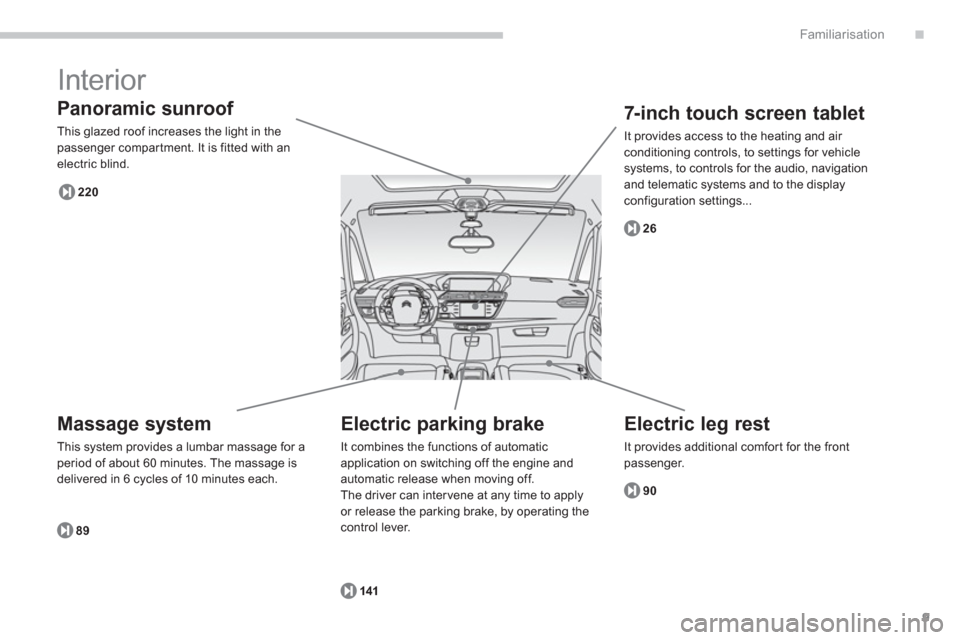
.
9
Familiarisation
Interior
Panoramic sunroof
This glazed roof increases the light in thepassenger compar tment. It is fitted with anelectric blind.
89
220
2
6
90
141
Massage system
This system provides a lumbar massage for aperiod of about 60 minutes. The massage is
delivered in 6 cycles of 10 minutes each.
Electric leg rest
It provides additional comfort for the frontpassenger.
7-inch touch screen tablet
It provides access to the heating and air conditioning controls, to settings for vehicle
systems, to controls for the audio, navigation
and telematic systems and to the display configuration settings...
Electric parking brake
It combines the functions of automatic application on switching off the engine and automatic release when moving off.
The driver can inter vene at any time to apply
or release the parkin
g brake, by operating the control lever.
Page 12 of 420
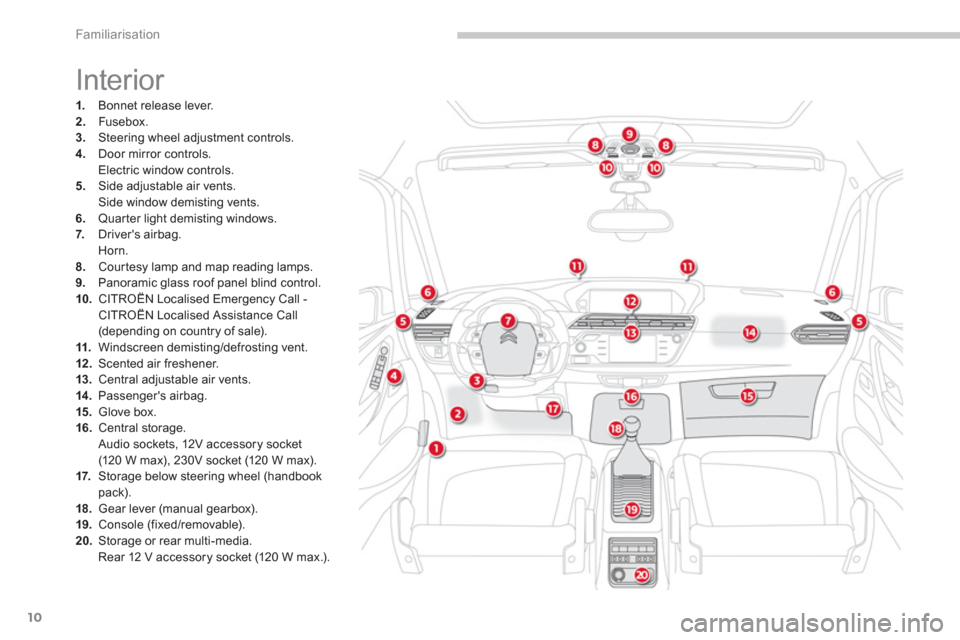
10
Familiarisation
Interior
1.
Bonnet release lever.2.
Fusebox.3.
Steering wheel adjustment controls. 4.
Door mirror controls.Electric window controls.5.
Side adjustable air vents.Side window demisting vents.
6.Quar ter light demisting windows.
7
. Driver's airbag.
Horn. 8.Courtesy lamp and map reading lamps. 9. Panoramic glass roof panel blind control. 10.CITROËN Localised Emergency Call - CITROËN Localised Assistance Call(depending on country of sale).11.
Windscreen demisting/defrosting vent.12.Scented air freshener.13.Central adjustable air vents.14.Passenger's airbag. 15.
Glove box.16.
Central storage.
Audio sockets, 12V accessory socket (120 W max), 230V socket (120 W max).17.Storage below steering wheel (handbookpack). 18.Gear lever (manual gearbox). 19. Console (fixed/removable).
20.
Storage or rear multi-media.
Rear 12 V accessory socket (120 W max.).
Page 26 of 420
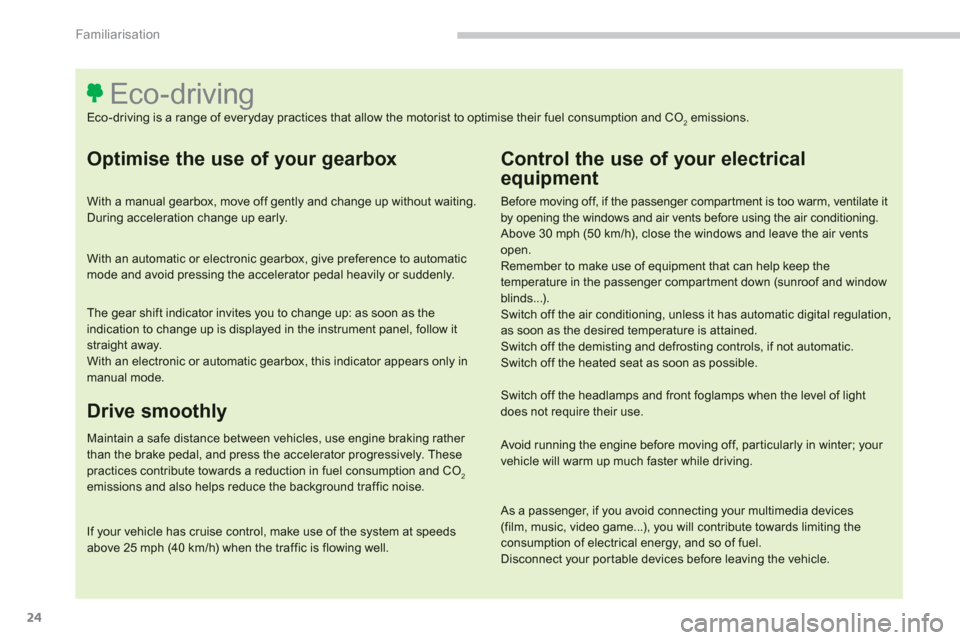
24
Familiarisation
Optimise the use of your gearbox
With a manual gearbox, move off gently and change up without waiting. During acceleration change up early.
With an automatic or electronic gearbox, give preference to automatic mode and avoid pressing the accelerator pedal heavily or suddenly.
Control the use of your electrical
equipment
Before moving off, if the passenger compartment is too warm, ventilate it by opening the windows and air vents before using the air conditioning.
Above 30 mph (50 km/h), close the windows and leave the air ventsopen.
Remember to make use of equipment that can help keep the temperature in the passenger compar tment down (sunroof and windowblinds...).
Switch off the air conditioning, unless it has automatic digital regulation,as soon as the desired temperature is attained.
Switch off the demisting and defrosting controls, if not automatic.
Switch off the heated seat as soon as possible.
Switch off the headlamps and front foglamps when the level of lightdoes not require their use.
Avoid running the engine before moving off, par ticularly in winter; your vehicle will warm up much faster while driving.
As a passenger, if you avoid connecting your multimedia devices (film, music, video game...), you will contribute towards limiting the
consumption of electrical energy, and so of fuel.
Disconnect your por table devices before leaving the vehicle.
Eco-driving
Eco-driving is a range of everyday practices that allow the motorist to optimise their fuel consumption and CO2 emissions.
Drive smoothly
Maintain a safe distance between vehicles, use engine braking rather than the brake pedal, and press the accelerator progressively. These practices contribute towards a reduction in fuel consumption and CO2emissions and also helps reduce the background traffic noise.
If your vehicle has cruise control, make use of the system at speedsabove 25 mph (40 km/h) when the traffic is flowing well.
The gear shift indicator invites you to change up: as soon as theindication to change up is displayed in the instrument panel, follow it straight away.
With an electronic or automatic gearbox, this indicator appears only in manual mode.
Page 27 of 420
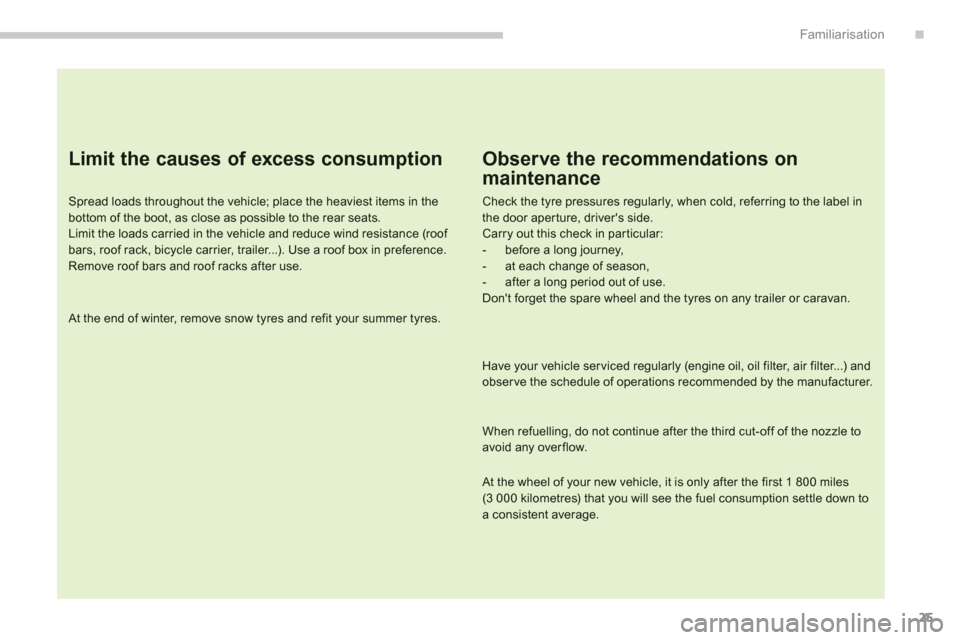
.
25
Familiarisation
Limit the causes of excess consumption
Spread loads throughout the vehicle; place the heaviest items in the bottom of the boot, as close as possible to the rear seats.
Limit the loads carried in the vehicle and reduce wind resistance (roof bars, roof rack, bicycle carrier, trailer...). Use a roof box in preference.
Remove roof bars and roof racks after use.
At the end of winter, remove snow tyres and refit your summer tyres.
Observe the recommendations on
maintenance
Check the tyre pressures regularly, when cold, referring to the label inthe door aperture, driver's side. Carry out this check in par ticular:
- before a long journey,
- at each change of season,
- after a long period out of use.
Don't forget the spare wheel and the tyres on any trailer or caravan.
Have your vehicle ser viced regularly (engine oil, oil filter, air filter...) andobser ve the schedule of operations recommended by the manufacturer.
When refuelling, do not continue after the third cut-off of the nozzle toavoid any over flow.
At the wheel of your new vehicle, it is only after the first 1 800 miles (3 000 kilometres) that you will see the fuel consumption settle down toa consistent average.
Page 222 of 420
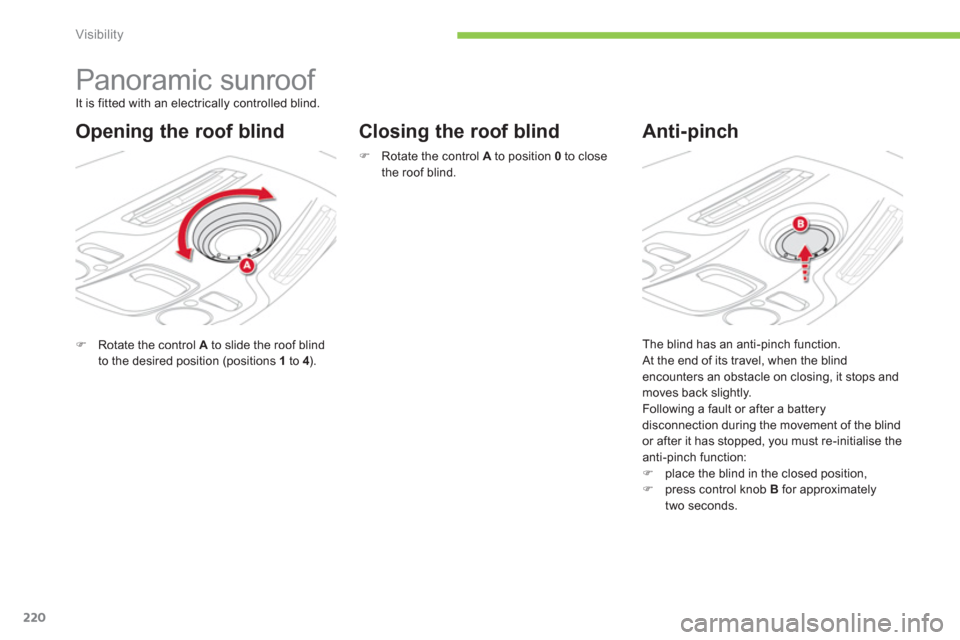
220
Visibility
Panoramic sunroof
�)Rotate the control Ato slide the roof blindto the desired position (positions 1
to 4 ).
Closing the roof blind
Anti-pinch
It is fitted with an electrically controlled blind.
Opening the roof blind
�)
Rotate the control A
to position 0
to closethe roof blind.
The blind has an anti-
pinch function. At the end of its travel, when the blind encounters an obstacle on closing, it stops andmoves back slightly.
Following a fault or after a batterydisconnection during the movement of the blind
or after it has stopped, you must re-initialise the
anti-pinch function:�)place the blind in the closed position,�)press control knob Bfor approximatelytwo seconds.
Page 234 of 420
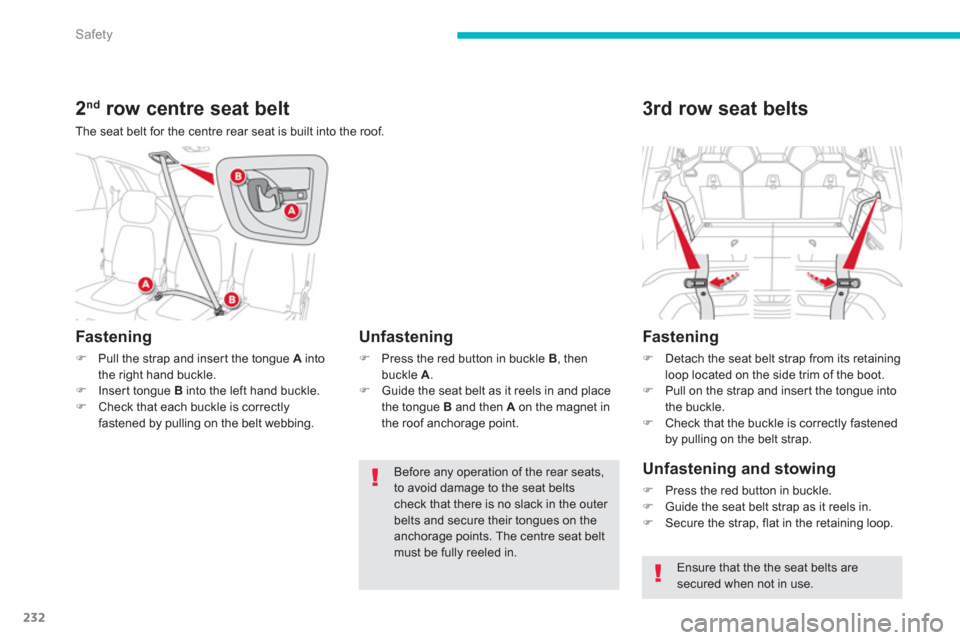
232
Safety
2 nd row centre seat belt
The seat belt for the centre rear seat is built into the roof.
Fastening
�)Pull the strap and inser t the tongue A
into
the right hand buckle.�)Inser t tongue Binto the left hand buckle.�)Check that each buckle is correctlyfastened by pulling on the belt webbing.
Unfastening
�)
Press the red button in buckle B , then buckle A.�)
Guide the seat belt as it reels in and place
the tongue Band then A on the magnet in
the roof anchorage point.
Before any operation of the rear seats,to avoid damage to the seat belts check that there is no slack in the outer belts and secure their tongues on the anchorage points. The centre seat beltmust be fully reeled in.
3rd row seat belts
Fastening
�)Detach the seat belt strap from its retainingloop located on the side trim of the boot. �)Pull on the strap and inser t the tongue into
the buckle. �)Check that the buckle is correctly fastened
b
y pulling on the belt strap.
Unfastening and stowing
�)Press the red button in buckle. �)Guide the seat belt strap as it reels in.�)Secure the strap, flat in the retaining loop.
Ensure that the the seat belts are secured when not in use.
Page 242 of 420
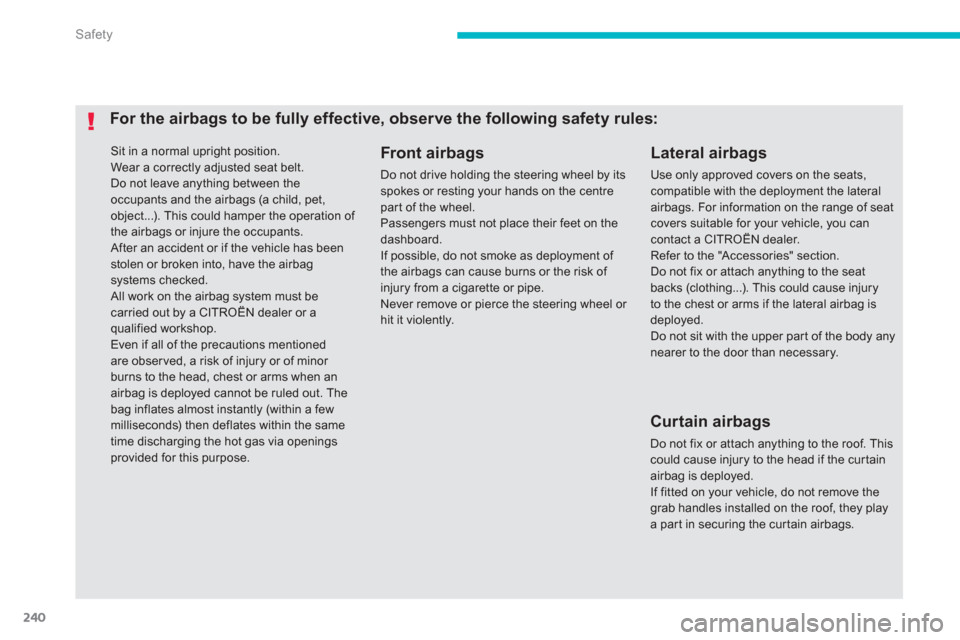
240
Safety
Sit in a normal upright position. Wear a correctly adjusted seat belt. Do not leave anything between theoccupants and the airbags (a child, pet,object...). This could hamper the operation of
the airbags or injure the occupants. After an accident or if the vehicle has beenstolen or broken into, have the airbagsystems checked. All work on the airbag system must be carried out by a CITROËN dealer or a qualified workshop.
Even if all of the precautions mentioned are obser ved, a risk of injury or of minor burns to the head, chest or arms when an airbag is deployed cannot be ruled out. Thebag inflates almost instantly (within a few milliseconds) then deflates within the sametime discharging the hot gas via openings provided for this purpose.
Front airbags
Do not drive holding the steering wheel by its spokes or resting your hands on the centre part of the wheel.
Passengers must not place their feet on thedashboard.
If possible, do not smoke as deployment of the airbags can cause burns or the risk of injury from a cigarette or pipe.
Never remove or pierce the steering wheel or hit it violently.
For the airbags to be fully effective, observe the following safety rules:
Lateral airbags
Use only approved covers on the seats, compatible with the deployment the lateral airbags. For information on the range of seatcovers suitable for your vehicle, you can contact a CITROËN dealer. Refer to the "Accessories" section.Do not fix or attach anything to the seat backs (clothing...). This could cause injuryto the chest or arms if the lateral airbag isdeployed.Do not sit with the upper par t of the body anynearer to the door than necessary.
Curtain airbags
Do not fix or attach anything to the roof. Thiscould cause injury to the head if the cur tainairbag is deployed.
If fitted on your vehicle, do not remove the grab handles installed on the roof, they playa par t in securing the cur tain airbags.
Page 306 of 420
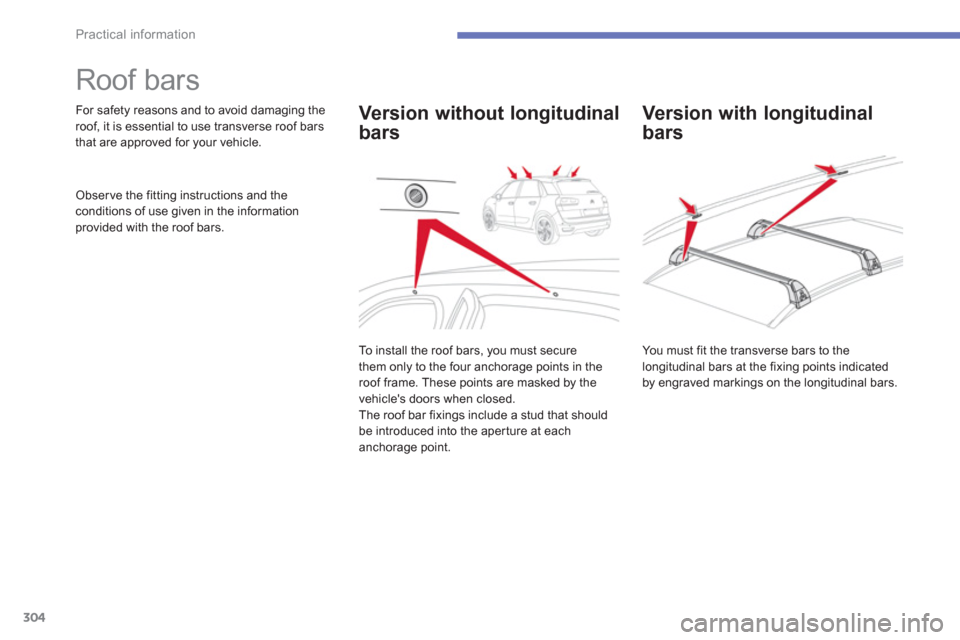
304
Practical information
Roof bars
For safety reasons and to avoid damaging the roof, it is essential to use transverse roof bars
that are approved for your vehicle.
Obser ve the fittin
g instructions and the conditions of use given in the information
provided with the roof bars.
Version with longitudinal
bars
To install the roof bars, you must secure
them only to the four anchorage points in theroof frame. These points are masked by the
vehicle's doors when closed.
The roof bar fixings include a stud that shouldbe introduced into the aper ture at eachanchorage point.
Version without longitudinal
bars
You must fit the transverse bars to the
longitudinal bars at the fixing points indicated
by engraved markings on the longitudinal bars.
Page 307 of 420
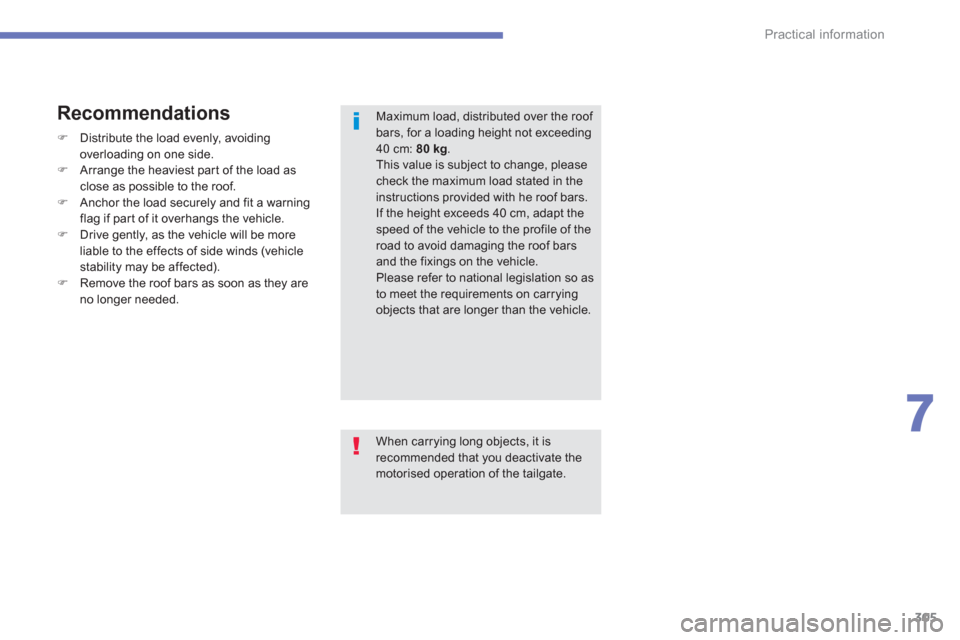
305
7
Practical information
Maximum load, distributed over the roof bars, for a loading height not exceeding 40 cm: 80 kg.
This value is subject to change, pleasecheck the maximum load stated in theinstructions provided with he roof bars.If the height exceeds 40 cm, adapt the
speed of the vehicle to the profile of the road to avoid damaging the roof barsand the fixings on the vehicle. Please refer to national legislation so as to meet the requirements on carryingobjects that are longer than the vehicle.
�)Distribute the load evenly, avoidingoverloading on one side.�)Arrange the heaviest par t of the load as close as possible to the roof. �)Anchor the load securely and fit a warning
flag if par t of it overhangs the vehicle.
�)Drive gently, as the vehicle will be more
liable to the effects of side winds (vehicle stability may be affected). �)Remove the roof bars as soon as they areno longer needed.
Recommendations
When carrying long objects, it is recommended that you deactivate the motorised operation of the tailgate.